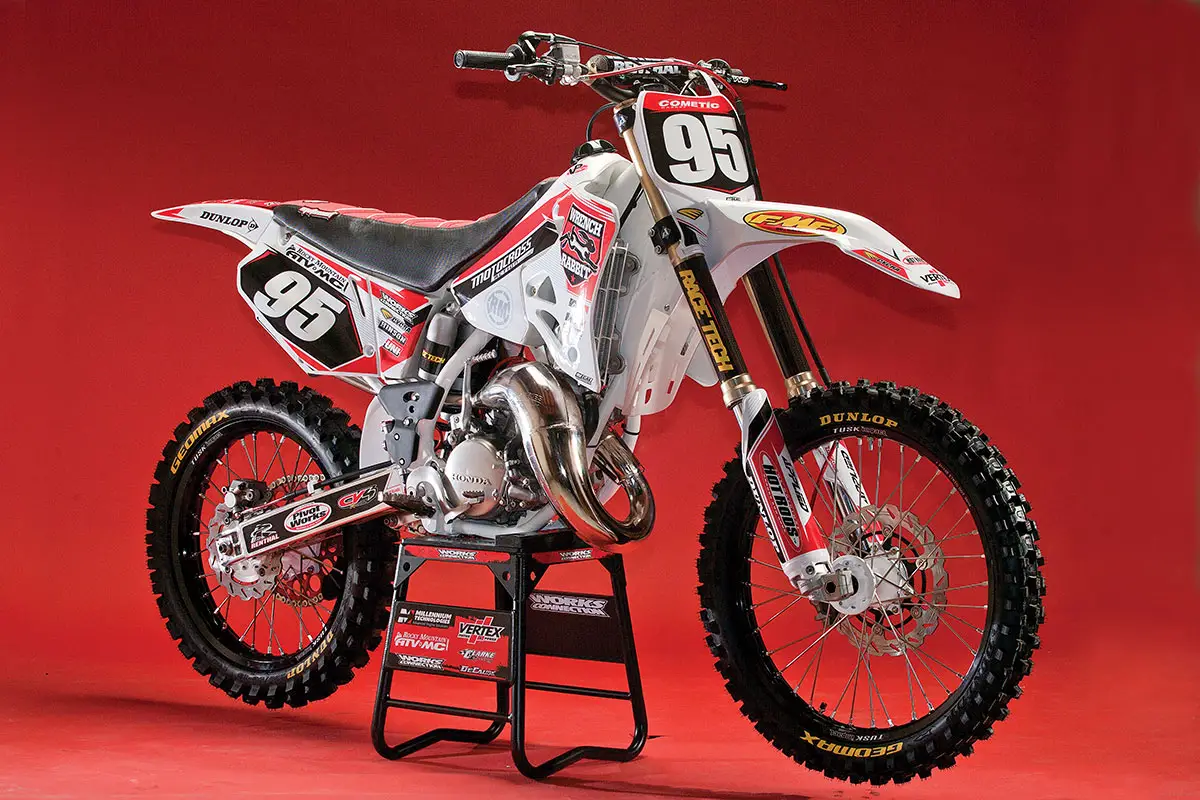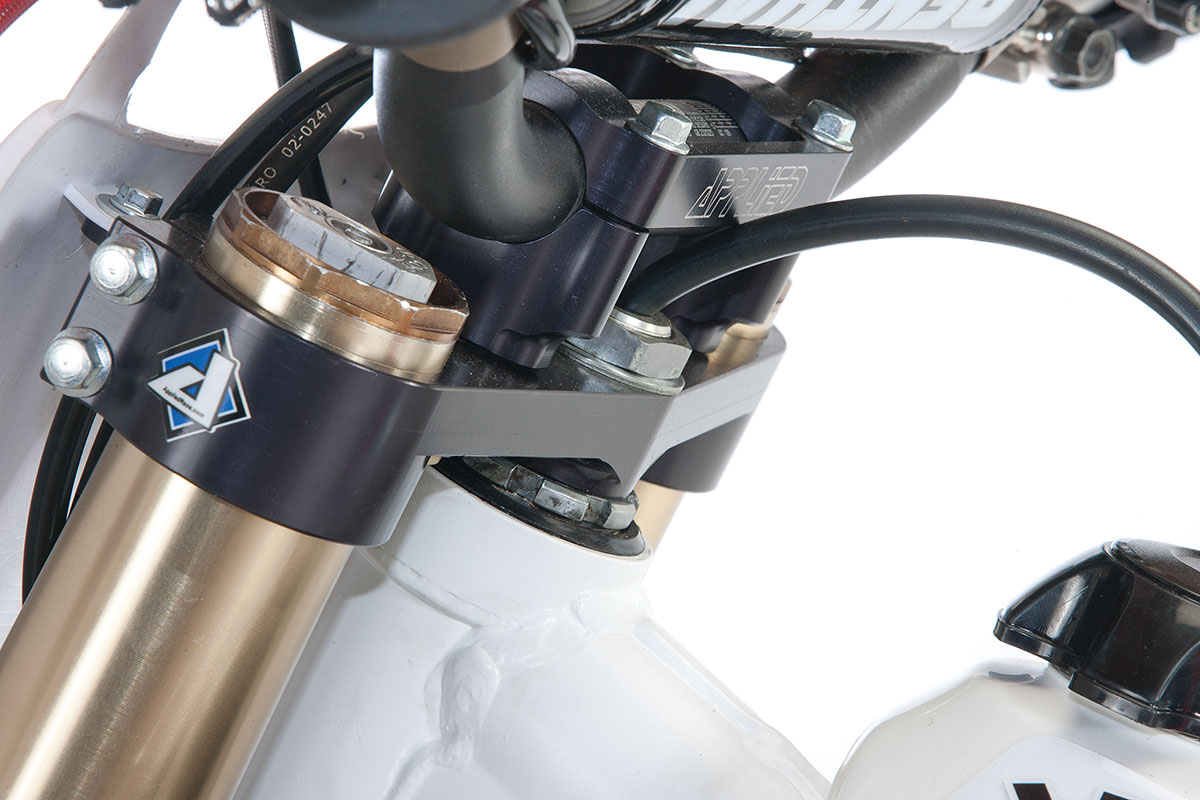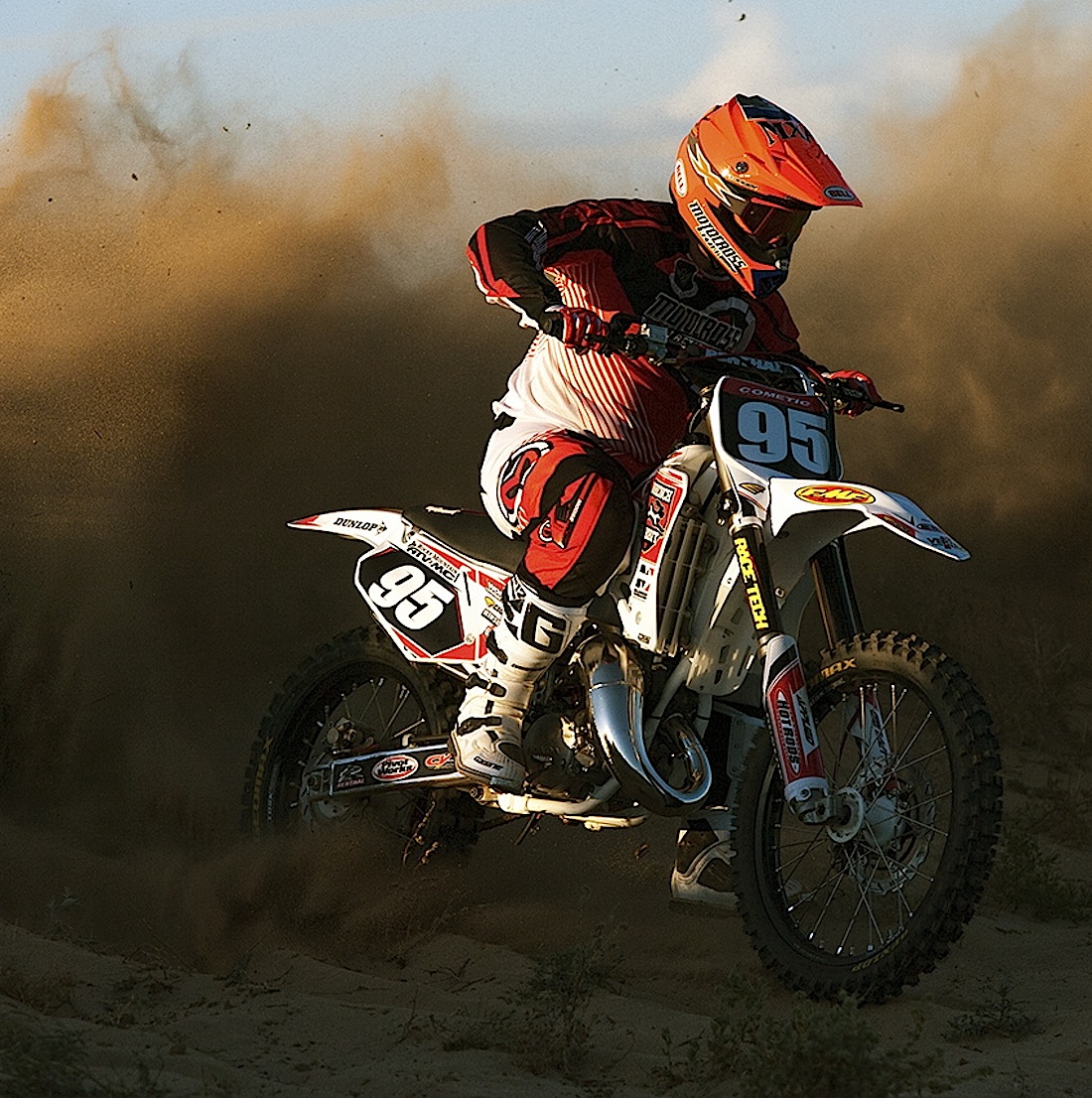TWO-STROKE TEST: MAKING A 1995 HONDA CR125 BETTER THAN NEW

We all remember the good, the bad and the ugly of the bikes we grew up with. Rewinding the memories from 20 years ago feels like a trip to a different world. By today’s standards, the bikes of yesteryear were slow, poorly suspended and crude looking. It doesn’t take a genius to see that the bikes we loved to race 20 years ago wouldn’t hold a candle to the bikes we race today. But, what if you could update your favorite bike from the past with new-school technology?
That is what the MXA gang wanted to do when we ran across a barn-find 1995 Honda CR125. We thought about just restoring it from head to toe, but just staring at a show pony has never been our cup of tea. Then, it hit us. We would make this old dog young. But how? Trial and error. Over the course of the next month, we tried numerous modern parts in hopes that they could be transferred across the 24-year gap—but nothing slipped on like Cinderella’s shoe. That didn’t stop us; it just meant that we needed machining, fabricating and custom work to bring our dream to fruition. The ultimate goal for our old warhorse was to make it blazing fast, better handling, more reliable, super suspended and, of course, more stylish than when it rolled off the showroom floor two decades ago.
 We used a few tricks to make our two decade old CR125 two-stroke look more modern.
We used a few tricks to make our two decade old CR125 two-stroke look more modern.
Honda’s 125cc machines of the early ’90s were built for speed, but Honda was under intense pressure from its competition. The 1995 CR125 had lackluster bottom-end power but a hard-hitting midrange and decent rev on top. By 1995 it was an engine that had grown long in the tooth, as it had been virtually unchanged for half a decade. It may have been on its last legs as a race engine, but it was still a bike that could be made to work in the hands of talented racers—evidenced by the fact that Doug Henry and Steve Lamson dominated the 125cc AMA National Championship from 1993 to 1996 on their factory-prepped CR125s. The engine could be made to work, even 21 years later, but could we fix the rest of the ancient warrior?
UNDER FEDERAL LAW, A MANUFACTURER ONLY HAS TO KEEP PARTS IN STOCK FOR A DISCONTINUED MODEL FOR SIX YEARS. THIS IS UNFORTUNATE FOR EVERY BIKE RESTORER, BECAUSE MANY MUCH-NEEDED PARTS ARE NOT AVAILABLE ANYMORE—AND THE AFTERMARKET IS NOT RUSHING TO BUILD NEW PARTS FOR 24-YEAR-OLD MACHINES.
Our CR125 had been sitting idle. The engine needed a total update, and the suspension was grim. Step one was to tear it down and thoroughly inspect every bolt, bearing, nut, seal and widget. We stripped it to the frame, split the cases and searched for modern replacement parts. The frame was in good shape, so we spent some time roughing up the paint before sending it to San Diego Power Coating to get a fresh coat of white paint electrostatically applied.
We didn’t want to leave anything to chance on the engine, so we set out to replace all the important parts without busting the bank. Luckily, Wrench Rabbit makes a complete rebuild kit that includes all the parts you need to get an old steed up and running again. Wrench Rabbit’s CR125 kit included the crankshaft, main bearings, piston, rings, transmission bearings and all the gaskets necessary to make the engine new again. Best of all, it came in one box—no need to chase after individual part numbers.

Under federal law, a manufacturer only has to keep parts in stock for a discontinued model for six years. This is unfortunate for every bike restorer, because many much-needed parts are not available anymore—and the aftermarket is not rushing to build new parts for 24-year-old machines. In our case, the stock 1995 cylinder was thrashed. We searched for used cylinders, but it was hard to find anything of quality. From looking at the bore, we assumed that our cylinder wasn’t salvageable, but we sent it to Millennium Technology to be evaluated. As luck would have it, Millennium was able to re-plate our CR125 cylinder and work magic on the cylinder head. They saved our bacon.
The frame and engine were the easy parts, requiring only a modicum of mechanical acumen. After that the headaches began. We didn’t even want to mess with the stock Kayaba forks. They were atrocious in 1995 and really not ready to handle the high-flying antics of modern motocross tracks. At first we tried to retrofit any new-age fork that would mate with our CR125’s stock clamps. There was no match. The closest affordable combination we found was a set of Showa forks from a 2008 Honda CRF450. But, in order to get the 13-year-newer forks to fit, we needed custom triple clamps machined. No problem. We had a pleasant experience with Applied Racing when they built us a set of KTM triple clamps that accepted Kayaba SSS forks a year ago. So, we asked the guys at Applied to make 1995 Honda CR125 clamps that would accept 2008 Honda CRF450 forks and 2016 CRF450 plastic. While we waited for the triple clamps, we sent the forks (and shock) to Race Tech to get them valved and sprung.
New troubles kept popping up. Thanks to our new forks, we had to throw the dated CR125 front-brake system away because it wouldn’t fit on the new 2008 fork lugs. We bit the bullet and went to the used-parts market to get an entire front-brake system from a 2008 CRF450. As for the rear brake, the complete 2008 CRF450 brake system would not mount up to the old swingarm. Still, we used the 2008 integrated master cylinder, which forced us to cut the old-school remote brake-fluid reservoir bottle off the frame.
EVERY MXA TEST RIDER WANTED TO TRY IT, BUT NOBODY WANTED TO BE THE FIRST. THEY WERE A BIT LEERY ABOUT POUNDING OUT LAPS
ON A 21-YEAR-OLD BIKE.
At this point our 1995 Honda CR125 was golden. It ran, the frame was refurbished and the forks were first-rate. To button it up, we made a few other updates: (1) Wider titanium Raptor footpegs (for a KTM); (2) A 2007 CR125 aluminum ignition cover (instead of the old plastic one); (3) UFO number plates that we cut to create a modern look; (4) A Moto Tassinari V-Force reed cage; (5) Cycra front fender and Stadium front number plate; (6) New clutch plates and springs; (7) An FMF pipe and silencer; (8) DeCal Works graphics kit; (9) Dunlop MX32 tires.

When the time came to ride our renovated and refreshed CR125, every MXA test rider wanted to try it, but nobody wanted to be the first. They were a bit leery about pounding out laps on a 24-year-old bike. They were reassured when the bike started on the first kick and delivered that raspy vibrato that was the hallmark of one-two-fives of the 1990s. So, what was it like to ride it?
Okay, it wasn’t rocket-ship fast, but this comes from riders who have been lulled into senility by the metronome power of 450cc four-strokes. It took the four-stroke-bred test riders a little while to adapt to the pipey CR125 powerband. Once they began to click with the high-rpm shift points and the need to keep the engine percolating above the midrange, they began to rip off decent lap times. Other than the engine being underpowered by today’s standards, everyone loved this bike. It didn’t hurt that it was better than when it was showroom fresh.

The modern Race Tech-tuned 2008 Honda forks were supple on hard hits and handled well over the chop. They were a giant step in the right direction. At first the front end wanted to push in the corners, but once we recognized this fact, we slid the forks up in the clamps to bring the 1995 chassis back into its sweet spot. With the forks up in the clamps, the head angle became steeper and more weight was transferred to the front tire. This allowed the CR125 to take advantage of its light weight, crisper powerband and vastly improved suspension. Everything else was spot-on. The updated brakes, wider footpegs and clean ergos gave this old dog a modern feel.
This was not an easy project by any means. We spent considerable time and money making this bike all it could be, and it was all worth it when we could go to the local racetrack with a 24-year-old Honda CR125 and embarrass lots of guys on the newest, latest, greatest machines. We weren’t just remembering one of our favorite bikes from the past; we were racing it.
1995 HONDA CR125 SUPPLIER LIST
Rocky Mountain ATV/MC: www.rockymountainatvmc.com
Wrench Rabbit: www.wrenchrabbit.com
Millennium Tech: www.mt-llc.com
Applied Racing: www.appliedrace.com
FMF Racing: www.fmfracing.com
Moto Tassinari: www.mototassinari.com
Race Tech: www.racetech.com
San Diego Powder Coating: www.sandiegopowdercoating.com
Dunlop Tire: www.dunlopmotorcycle.com
DeCal Works: www.decalmx.com
ICW: www.icwbikestands.com
Uni Filter: www.unifilter.com
Hinson Clutch Components: www.hinsonracing.com
Pivot Works: www.pivotworks.com
Renthal: www.renthal.com
Moto Seat: www.motoseat.com
Works Connection: www.worksconnection.com
TCR Wheels: www.wheellacing.com
Tusk: www.tuskoffroad.com
Motomaster: www.moto-masterusa.com
Regina Chain: www.reginachain.net
Cycra Racing: www.cycraracing.com
CV4: www.cv4.net
Klotz Synthetic Lubricants: www.klotzlube.com
Ride Engineering: www.ride-engineering.com






Comments are closed.